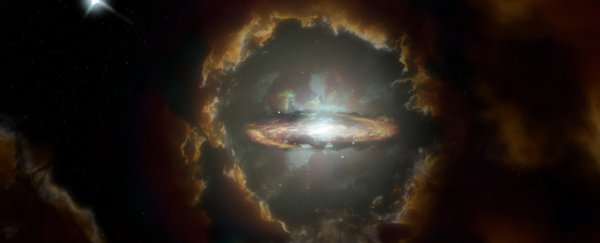Around 13.8 billion years ago, somehow the Universe popped into existence. But it didn't come fully equipped. At some point, the first stars formed, and the first galaxies. How and when this happened is still a mystery astronomers are trying to solve… but one galaxy could have a vitally important key.
It's called DLA0817g - nicknamed the Wolfe Disk - a cool, rotating, gas-rich disc galaxy with a mass of about 72 billion times that of our Sun. And the Atacama Large Millimeter/submillimeter Array has snapped it a massive 12.5 billion light-years away - when the Universe was just 10 percent of its current age.
It's the earliest rotating disc galaxy astronomers have found yet, and its very existence changes our understanding of galaxy formation in the early Universe.
Most of the galaxies in the early Universe are a hot mess, literally. They're all blobby, with stars flying every which way, and rather high temperatures. Astronomers have interpreted this to mean that they grew large by colliding and merging with other galaxies - a hot, messy process.
"Most galaxies that we find early in the Universe look like train wrecks because they underwent consistent and often 'violent' merging," explained astronomer Marcel Neeleman of the Max Planck Institute for Astronomy in Germany.
"These hot mergers make it difficult to form well-ordered, cold rotating disks like we observe in our present Universe."
Under this scenario, it takes a long time for the galaxies to cool down and smooth out into the more orderly rotating disc galaxies like the Milky Way. We don't generally start seeing them until about 4 to 6 billion years after the Big Bang.
This is the "hot" mode of galaxy formation. But astronomers had also predicted and simulated another way - the "cold" mode.
First, you need to start with the primordial soup, an ionised quark-gluon plasma that filled the Universe before the formation of matter. To go from this homogeneous plasma to a Universe filled with stuff, astrophysicists have run simulations that suggest dark matter is responsible.
We don't know what dark matter is. We can't detect it directly, but it interacts gravitationally with normal matter. It helps to hold galaxies together, and we believe that it could be crucial to galaxy formation, clumps of it pulling together gas and stars into galaxies.
Supercomputer simulations have shown that a massive network of dark matter in the early Universe could have facilitated the formation of cool galaxies. If the gas was cool to start with, it could have been fed along filaments of the network into the dark matter clumps, accreting into large, cool, orderly disc galaxies.
But the only way to confirm this model is through observational evidence, so the researchers went looking, using the light of even more distant galaxies, called quasars, to illuminate the way.
Distant galaxies are very hard to see, but quasars are among the most luminous objects in the Universe - galaxies lit by an active supermassive black hole, the space around it blasting out radiation as it feeds. The team turned ALMA's powerful capabilities to these distant quasars, looking for signatures in their light that showed that it had passed through a gas-filled galaxy on the way.
They found it. The light from one of the quasars they imaged had passed through a region rich with hydrogen - the signature of the Wolfe Disk.
And there was something else. The light on one side of the disc was compressed, or blueshifted. We see this when something is moving towards us. And the light from the other side was stretched, or redshifted - moving away from us. The object was rotating.
Those Doppler shifts, as they are known, then allowed the researchers to calculate the velocity of the galaxy's rotation: around 272 kilometres per second.
What's even more wild is that the team believes the Wolfe Disk isn't one of a kind.
"The fact that we found the Wolfe Disk using this method, tells us that it belongs to the normal population of galaxies present at early times," Neeleman said.
"When our newest observations with ALMA surprisingly showed that it is rotating, we realised that early rotating disk galaxies are not as rare as we thought and that there should be a lot more of them out there."
The team will continue their search for these galaxies to find out just how common cold accretion was in the early Universe.
The research has been published in Nature.
